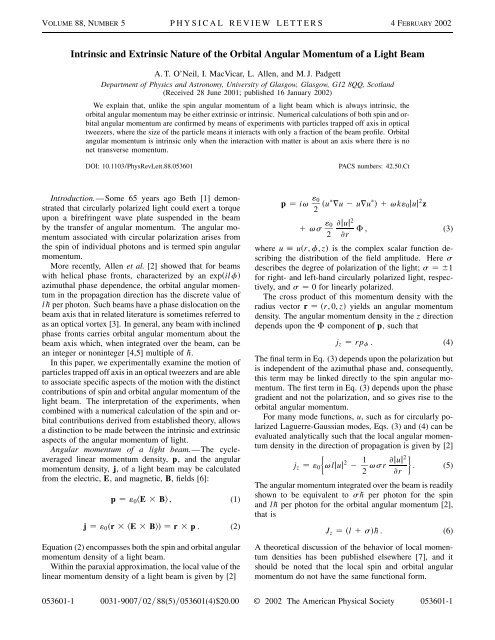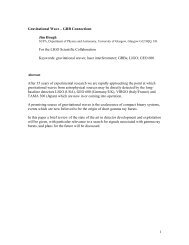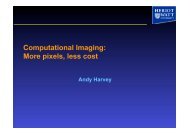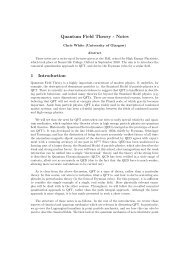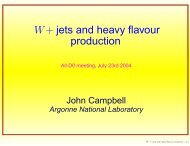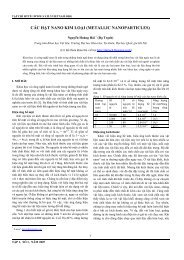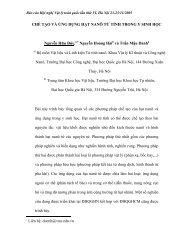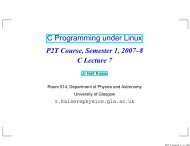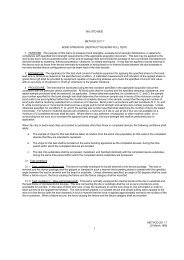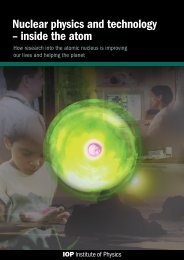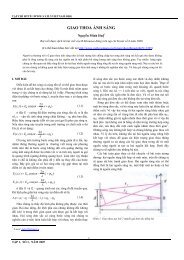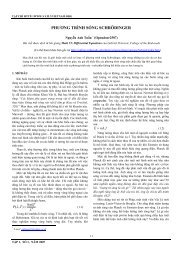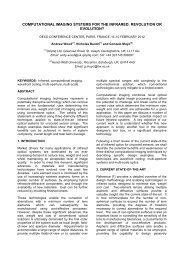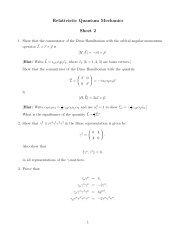Intrinsic and Extrinsic Nature of the Orbital Angular Momentum of a ...
Intrinsic and Extrinsic Nature of the Orbital Angular Momentum of a ...
Intrinsic and Extrinsic Nature of the Orbital Angular Momentum of a ...
Create successful ePaper yourself
Turn your PDF publications into a flip-book with our unique Google optimized e-Paper software.
VOLUME 88, NUMBER 5 PHYSICAL REVIEW LETTERS 4FEBRUARY 2002<br />
<strong>Intrinsic</strong> <strong>and</strong> <strong>Extrinsic</strong> <strong>Nature</strong> <strong>of</strong> <strong>the</strong> <strong>Orbital</strong> <strong>Angular</strong> <strong>Momentum</strong> <strong>of</strong> a Light Beam<br />
A. T. O’Neil, I. MacVicar, L. Allen, <strong>and</strong> M. J. Padgett<br />
Department <strong>of</strong> Physics <strong>and</strong> Astronomy, University <strong>of</strong> Glasgow, Glasgow, G12 8QQ, Scotl<strong>and</strong><br />
(Received 28 June 2001; published 16 January 2002)<br />
We explain that, unlike <strong>the</strong> spin angular momentum <strong>of</strong> a light beam which is always intrinsic, <strong>the</strong><br />
orbital angular momentum may be ei<strong>the</strong>r extrinsic or intrinsic. Numerical calculations <strong>of</strong> both spin <strong>and</strong> orbital<br />
angular momentum are confirmed by means <strong>of</strong> experiments with particles trapped <strong>of</strong>f axis in optical<br />
tweezers, where <strong>the</strong> size <strong>of</strong> <strong>the</strong> particle means it interacts with only a fraction <strong>of</strong> <strong>the</strong> beam pr<strong>of</strong>ile. <strong>Orbital</strong><br />
angular momentum is intrinsic only when <strong>the</strong> interaction with matter is about an axis where <strong>the</strong>re is no<br />
net transverse momentum.<br />
DOI: 10.1103/PhysRevLett.88.053601<br />
PACS numbers: 42.50.Ct<br />
Introduction.—Some 65 years ago Beth [1] demonstrated<br />
that circularly polarized light could exert a torque<br />
upon a birefringent wave plate suspended in <strong>the</strong> beam<br />
by <strong>the</strong> transfer <strong>of</strong> angular momentum. The angular momentum<br />
associated with circular polarization arises from<br />
<strong>the</strong> spin <strong>of</strong> individual photons <strong>and</strong> is termed spin angular<br />
momentum.<br />
More recently, Allen et al. [2] showed that for beams<br />
with helical phase fronts, characterized by an expilf<br />
azimuthal phase dependence, <strong>the</strong> orbital angular momentum<br />
in <strong>the</strong> propagation direction has <strong>the</strong> discrete value <strong>of</strong><br />
l ¯h per photon. Such beams have a phase dislocation on <strong>the</strong><br />
beam axis that in related literature is sometimes referred to<br />
as an optical vortex [3]. In general, any beam with inclined<br />
phase fronts carries orbital angular momentum about <strong>the</strong><br />
beam axis which, when integrated over <strong>the</strong> beam, can be<br />
an integer or noninteger [4,5] multiple <strong>of</strong> ¯h.<br />
In this paper, we experimentally examine <strong>the</strong> motion <strong>of</strong><br />
particles trapped <strong>of</strong>f axis in an optical tweezers <strong>and</strong> are able<br />
to associate specific aspects <strong>of</strong> <strong>the</strong> motion with <strong>the</strong> distinct<br />
contributions <strong>of</strong> spin <strong>and</strong> orbital angular momentum <strong>of</strong> <strong>the</strong><br />
light beam. The interpretation <strong>of</strong> <strong>the</strong> experiments, when<br />
combined with a numerical calculation <strong>of</strong> <strong>the</strong> spin <strong>and</strong> orbital<br />
contributions derived from established <strong>the</strong>ory, allows<br />
a distinction to be made between <strong>the</strong> intrinsic <strong>and</strong> extrinsic<br />
aspects <strong>of</strong> <strong>the</strong> angular momentum <strong>of</strong> light.<br />
<strong>Angular</strong> momentum <strong>of</strong> a light beam.—The cycleaveraged<br />
linear momentum density, p, <strong>and</strong> <strong>the</strong> angular<br />
momentum density, j, <strong>of</strong> a light beam may be calculated<br />
from <strong>the</strong> electric, E, <strong>and</strong> magnetic, B, fields [6]:<br />
p ´0E 3 B , (1)<br />
j ´0r 3 E 3 B r 3 p . (2)<br />
Equation (2) encompasses both <strong>the</strong> spin <strong>and</strong> orbital angular<br />
momentum density <strong>of</strong> a light beam.<br />
Within <strong>the</strong> paraxial approximation, <strong>the</strong> local value <strong>of</strong> <strong>the</strong><br />
linear momentum density <strong>of</strong> a light beam is given by [2]<br />
p iv ´0<br />
2 u =u 2 u=u 1vk´0juj 2 z<br />
1vs´0<br />
2<br />
≠juj 2<br />
≠r F , (3)<br />
where u ur, f, z is <strong>the</strong> complex scalar function describing<br />
<strong>the</strong> distribution <strong>of</strong> <strong>the</strong> field amplitude. Here s<br />
describes <strong>the</strong> degree <strong>of</strong> polarization <strong>of</strong> <strong>the</strong> light; s 61<br />
for right- <strong>and</strong> left-h<strong>and</strong> circularly polarized light, respectively,<br />
<strong>and</strong> s 0 for linearly polarized.<br />
The cross product <strong>of</strong> this momentum density with <strong>the</strong><br />
radius vector r r,0,z yields an angular momentum<br />
density. The angular momentum density in <strong>the</strong> z direction<br />
depends upon <strong>the</strong> F component <strong>of</strong> p, such that<br />
j z rp f . (4)<br />
The final term in Eq. (3) depends upon <strong>the</strong> polarization but<br />
is independent <strong>of</strong> <strong>the</strong> azimuthal phase <strong>and</strong>, consequently,<br />
this term may be linked directly to <strong>the</strong> spin angular momentum.<br />
The first term in Eq. (3) depends upon <strong>the</strong> phase<br />
gradient <strong>and</strong> not <strong>the</strong> polarization, <strong>and</strong> so gives rise to <strong>the</strong><br />
orbital angular momentum.<br />
For many mode functions, u, such as for circularly polarized<br />
Laguerre-Gaussian modes, Eqs. (3) <strong>and</strong> (4) can be<br />
evaluated analytically such that <strong>the</strong> local angular momentum<br />
density in <strong>the</strong> direction <strong>of</strong> propagation is given by [2]<br />
j z ´0<br />
Ωvljuj 2 2 1 æ<br />
≠juj2<br />
vsr . (5)<br />
2 ≠r<br />
The angular momentum integrated over <strong>the</strong> beam is readily<br />
shown to be equivalent to s ¯h per photon for <strong>the</strong> spin<br />
<strong>and</strong> l ¯h per photon for <strong>the</strong> orbital angular momentum [2],<br />
that is<br />
J z l 1s ¯h . (6)<br />
A <strong>the</strong>oretical discussion <strong>of</strong> <strong>the</strong> behavior <strong>of</strong> local momentum<br />
densities has been published elsewhere [7], <strong>and</strong> it<br />
should be noted that <strong>the</strong> local spin <strong>and</strong> orbital angular<br />
momentum do not have <strong>the</strong> same functional form.<br />
053601-1 0031-90070288(5)053601(4)$20.00 © 2002 The American Physical Society 053601-1
VOLUME 88, NUMBER 5 PHYSICAL REVIEW LETTERS 4FEBRUARY 2002<br />
As is well known, spin angular momentum does not<br />
depend upon <strong>the</strong> choice <strong>of</strong> axis <strong>and</strong> so is said to be intrinsic.<br />
The angular momentum which arises for any<br />
light beam from <strong>the</strong> product <strong>of</strong> <strong>the</strong> z component <strong>of</strong> linear<br />
momentum about a radius vector, may be said to be<br />
an extrinsic because its value depends upon <strong>the</strong> choice <strong>of</strong><br />
calculation axis.<br />
Berry showed [8] that <strong>the</strong> orbital angular momentum<br />
<strong>of</strong> a light beam does not depend upon <strong>the</strong> lateral position<br />
<strong>of</strong> <strong>the</strong> axis <strong>and</strong> can <strong>the</strong>refore also be said to be intrinsic,<br />
provided <strong>the</strong> direction <strong>of</strong> <strong>the</strong> axis is chosen so that <strong>the</strong><br />
transverse momentum is zero. When integrated over <strong>the</strong><br />
whole beam <strong>the</strong> angular momentum in <strong>the</strong> z direction is<br />
ZZ<br />
J z ´0 dx dy r 3 E 3 B . (7)<br />
If <strong>the</strong> axis is laterally displaced by r 0 r 0x , r 0y it is easy<br />
to show that <strong>the</strong> change in <strong>the</strong> z component <strong>of</strong> angular<br />
momentum is given by<br />
DJ z r 0x 3 P y 1 r 0y 3 P x <br />
ZZ<br />
r 0x´0 dx dy E 3 B y (8)<br />
1 r 0y´0<br />
ZZ<br />
dx dy E 3 B x .<br />
The angular momentum is intrinsic only if DJ z equals<br />
zero for all values <strong>of</strong> r 0x <strong>and</strong> r 0y . This condition is<br />
satisfied only if z is stipulatedRR as <strong>the</strong> direction for<br />
which RR <strong>the</strong> transverse momenta ´0 dx dy E 3 Bx <strong>and</strong><br />
´0 dx dy E 3 By are exactly zero.<br />
For Laguerre-Gaussian light beams truncated by apertures,<br />
Eqs. (3) <strong>and</strong> (8) can only be evaluated numerically.<br />
Never<strong>the</strong>less, for all apertures, <strong>of</strong> whatever size or position,<br />
<strong>the</strong> spin angular momentum remains s ¯h irrespective<br />
<strong>of</strong> <strong>the</strong> choice <strong>of</strong> calculation axis <strong>and</strong> so is, as<br />
expected, intrinsic; see Fig. 1. Any beam with a helical<br />
phase front apertured symmetrically about <strong>the</strong> beam axis<br />
has zero transverse momentum <strong>and</strong>, consequently, an<br />
orbital angular momentum <strong>of</strong> l ¯h per photon, independent<br />
<strong>of</strong> <strong>the</strong> axis <strong>of</strong> calculation. The orbital angular momentum<br />
<strong>of</strong> <strong>the</strong> light beam may <strong>the</strong>refore be described as intrinsic.<br />
However, when <strong>the</strong> beam is passed through an <strong>of</strong>f-axis<br />
aperture, its transverse momentum is nonzero <strong>and</strong> <strong>the</strong><br />
orbital angular momentum depends upon <strong>the</strong> choice <strong>of</strong><br />
calculation axis <strong>and</strong> so must be described as extrinsic;<br />
see Fig. 1. An interesting result occurs when <strong>the</strong> orbital<br />
angular momentum <strong>of</strong> <strong>the</strong> apertured beam is calculated<br />
about <strong>the</strong> original beam axis. Even though <strong>the</strong> transverse<br />
momentum is nonzero, <strong>the</strong> orbital angular momentum<br />
remains l ¯h per photon because r 0x <strong>and</strong> r 0y are both zero.<br />
However, it does not follow that <strong>the</strong> angular momentum <strong>of</strong><br />
<strong>the</strong> apertured beam is intrinsic as <strong>the</strong> result does depend<br />
upon <strong>the</strong> choice <strong>of</strong> calculation axis. When any beam<br />
is apertured <strong>of</strong>f axis, it is simpler <strong>and</strong> more accurate to<br />
underst<strong>and</strong> its interaction with particles by considering <strong>the</strong><br />
components <strong>of</strong> p in <strong>the</strong> x-y plane. For beams with helical<br />
phase fronts, <strong>the</strong>se transverse components are in <strong>the</strong> F<br />
direction with respect to <strong>the</strong> beam axis. It is this distinction<br />
between spin <strong>and</strong> orbital angular momentum which<br />
gives rise to differences in behavior for <strong>the</strong> interaction <strong>of</strong><br />
light with matter.<br />
The transfer <strong>of</strong> spin <strong>and</strong> orbital angular momentum to<br />
small particles.—The interaction <strong>of</strong> small particle with <strong>the</strong><br />
angular momentum <strong>of</strong> a light beam has been investigated<br />
by a number <strong>of</strong> groups with <strong>the</strong> use <strong>of</strong> optical tweezers.<br />
Usually implemented by use <strong>of</strong> a high numerical-aperture<br />
microscope, optical tweezers rely on <strong>the</strong> gradient force to<br />
confine a dielectric particle near <strong>the</strong> point <strong>of</strong> highest light<br />
intensity [9]. For particles trapped on <strong>the</strong> beam axis, both<br />
<strong>the</strong> spin <strong>and</strong> orbital angular momentum have been shown<br />
to cause rotation <strong>of</strong> birefringent [10] <strong>and</strong> absorptive [11]<br />
particles, respectively. For absorbing particles, both spin<br />
<strong>and</strong> orbital angular momenta are transferred with <strong>the</strong> same<br />
efficiency so that <strong>the</strong> applied torque is proportional to <strong>the</strong><br />
total angular momentum [12], that is s 1l ¯h per photon.<br />
In this present work we also use optical tweezers, but in<br />
this instance <strong>the</strong> particles are trapped away from <strong>the</strong> beam<br />
axis. This allows us to demonstrate <strong>the</strong> difference between<br />
particle interactions with spin <strong>and</strong> orbital angular momentum.<br />
The experimental configuration is shown in Fig. 2.<br />
Our optical tweezers are based on a 1.3 numerical aperture,<br />
3100 objective lens, configured with <strong>the</strong> trapping beam directed<br />
upwards, which allows easier access to <strong>the</strong> sample<br />
plane. This beam is generated from <strong>the</strong> 100 mW output <strong>of</strong><br />
a commercial Nd:YLF laser transformed, using a computer<br />
generated hologram, to give a Laguerre-Gaussian mode <strong>of</strong><br />
approximately 30 mW. The beam is circularly polarized,<br />
s 61 with a high azimuthal mode index, l 68. The<br />
sign <strong>of</strong> <strong>the</strong> spin or <strong>the</strong> orbital angular momentum may be<br />
reversed by <strong>the</strong> insertion <strong>of</strong> a half–wave plate or a Dove<br />
prism, respectively [13]. The radius <strong>of</strong> maximum intensity,<br />
r max <strong>of</strong> a Laguerre-Gaussian mode is given by [14],<br />
s<br />
z R l<br />
r max <br />
k , (9)<br />
where z R is <strong>the</strong> Rayleigh range <strong>of</strong> <strong>the</strong> beam. Even under<br />
<strong>the</strong> tight focusing associated with optical tweezers, <strong>the</strong><br />
peak intensity ring <strong>of</strong> a Laguerre-Gaussian mode <strong>of</strong> high<br />
index l may be made several mm in diameter <strong>and</strong>, consequently,<br />
be much larger than <strong>the</strong> particles it is attempting<br />
to trap.<br />
It is not surprising, for such conditions, that we observe<br />
<strong>the</strong> particles to be confined by <strong>the</strong> gradient force at <strong>the</strong> radius<br />
<strong>of</strong> maximum light intensity <strong>and</strong> not on <strong>the</strong> beam axis.<br />
When a birefringent particle such as a calcite fragment is<br />
trapped, <strong>and</strong> circularly polarized light is converted to linear,<br />
we observe that <strong>the</strong> particle spins about its own axis.<br />
The sense <strong>of</strong> rotation is governed by <strong>the</strong> h<strong>and</strong>edness <strong>of</strong> <strong>the</strong><br />
circular polarization.<br />
053601-2 053601-2
VOLUME 88, NUMBER 5 PHYSICAL REVIEW LETTERS 4FEBRUARY 2002<br />
FIG. 1. Numerically calculated local spin <strong>and</strong> orbital angular momentum densities in <strong>the</strong> direction <strong>of</strong> propagation for a l 8 <strong>and</strong><br />
s 1 Laguerre-Gaussian mode. A positive contribution is shown in white, gray represents zero, <strong>and</strong> black a negative contribution;<br />
<strong>the</strong> black spot marks <strong>the</strong> axis <strong>of</strong> <strong>the</strong> original beam, <strong>the</strong> white cross marks <strong>the</strong> axis about which <strong>the</strong> angular momenta are calculated<br />
<strong>and</strong>, where appropriate, <strong>the</strong> black circle marks <strong>the</strong> position <strong>of</strong> a s<strong>of</strong>t edged aperture. Note that <strong>the</strong> spin angular momentum is<br />
equivalent to s ¯h per photon irrespective <strong>of</strong> <strong>the</strong> choice <strong>of</strong> aperture or calculation axis, whereas <strong>the</strong> orbital angular momentum is only<br />
l ¯h per photon if <strong>the</strong> aperture or calculation axes coincide with <strong>the</strong> axis <strong>of</strong> <strong>the</strong> original beam.<br />
FIG. 2. The optical tweezers use a high-order Laguerre-<br />
Gaussian beam to trap <strong>the</strong> particle in <strong>the</strong> region <strong>of</strong> maximum<br />
light intensity, away from <strong>the</strong> beam axis. The circularly polarized<br />
Laguerre-Gaussian beam is generated using a quarter-wave<br />
plate <strong>and</strong> a hologram. The sense <strong>of</strong> <strong>the</strong> orbital <strong>and</strong> spin angular<br />
momentum can be reversed by <strong>the</strong> inclusion <strong>of</strong> a half-wave<br />
plate or a Dove prism, respectively.<br />
For small particles <strong>the</strong> force arising from <strong>the</strong> light scattering,<br />
<strong>the</strong> momentum recoil force, becomes important.<br />
For a tightly focused Laguerre-Gaussian mode, <strong>the</strong> dominant<br />
component <strong>of</strong> <strong>the</strong> scattering force lies in <strong>the</strong> direction<br />
<strong>of</strong> beam propagation. The gradient force again constrains<br />
<strong>the</strong> particle to <strong>the</strong> annulus <strong>of</strong> maximum beam intensity.<br />
However, as <strong>the</strong> intensity distribution is cylindrically<br />
symmetric, <strong>the</strong> particle is not constrained azimuthally.<br />
Because <strong>the</strong> particle is trapped <strong>of</strong>f <strong>the</strong> beam axis, <strong>the</strong> inclination<br />
<strong>of</strong> <strong>the</strong> helical phase fronts <strong>and</strong> <strong>the</strong> corresponding<br />
momentum result in a tangental force on <strong>the</strong> particle. We<br />
observe that a small particle, while still contained within<br />
<strong>the</strong> annular ring <strong>of</strong> light, orbits <strong>the</strong> beam axis in a direction<br />
determined by <strong>the</strong> h<strong>and</strong>edness <strong>of</strong> <strong>the</strong> helical phase fronts;<br />
see Fig. 3. We conclude that <strong>the</strong> larger calcite <strong>and</strong> small<br />
particles are interacting with intrinsic spin <strong>and</strong> extrinsic<br />
orbital angular momentum, respectively. In principle, it<br />
should be possible to observe both <strong>the</strong> orbital <strong>and</strong> spin<br />
angular momenta acting simultaneously upon <strong>the</strong> same<br />
small birefringent particle. However, our observations<br />
have been inconclusive as birefringent particles small<br />
enough for <strong>the</strong> scattering force to induce a rotation about<br />
<strong>the</strong> beam axis are typically too small to see whe<strong>the</strong>r <strong>the</strong>y<br />
are spinning about <strong>the</strong>ir own axis.<br />
This orbital <strong>and</strong> spin behavior is entirely consistent with<br />
<strong>the</strong> formulation summarized in Eqs. (7) <strong>and</strong> (8). If one<br />
considers <strong>the</strong> cross section <strong>of</strong> an <strong>of</strong>f-axis trapped particle<br />
to play <strong>the</strong> rôle <strong>of</strong> an aperture, <strong>the</strong>n we see that <strong>the</strong> intrinsic<br />
spin <strong>of</strong> <strong>the</strong> angular momentum creates a torque about <strong>the</strong><br />
053601-3 053601-3
VOLUME 88, NUMBER 5 PHYSICAL REVIEW LETTERS 4FEBRUARY 2002<br />
Time<br />
Orbit<br />
Spin<br />
particle’s own axis, causing it to spin. A calculation <strong>of</strong> <strong>the</strong><br />
particle’s angular momentum about an arbitrary axis shows<br />
a clear distinction between <strong>the</strong> intrinsic angular momentum<br />
associated with its spinning motion <strong>and</strong> <strong>the</strong> extrinsic angular<br />
momentum associated with its orbital motion. In this<br />
situation, orbital angular momentum is better described as<br />
<strong>the</strong> result <strong>of</strong> a linear momentum component directed at a<br />
tangent to <strong>the</strong> radius vector.<br />
Unlike <strong>the</strong> spin angular momentum <strong>of</strong> a light beam<br />
which is always intrinsic, <strong>the</strong> z component <strong>of</strong> <strong>the</strong> orbital<br />
angular momentum can be described as intrinsic only if<br />
<strong>the</strong> z direction can be stipulated such that <strong>the</strong> transverse<br />
momentum integrated over <strong>the</strong> whole beam is zero. If an<br />
interaction is with only a fraction <strong>of</strong> <strong>the</strong> beam cross section,<br />
<strong>the</strong>n <strong>the</strong> orbital angular as measured about <strong>the</strong> original<br />
axis is extrinsic.<br />
L. Allen is pleased to thank <strong>the</strong> Leverhulme Trust for<br />
its support. M. J. Padgett thanks <strong>the</strong> Royal Society for its<br />
support. A. T. O’Neil is supported by <strong>the</strong> EPSRC.<br />
FIG. 3. Successive video frames showing particles trapped<br />
near <strong>the</strong> focus <strong>of</strong> an l 8 <strong>and</strong> s 1 Laguerre-Gaussian<br />
mode. The left column shows particles <strong>of</strong> 1 mm diam. These<br />
particles are sufficiently small to be subject to a well-defined<br />
scattering force, allowing <strong>the</strong>m to interact with <strong>the</strong> orbital angular<br />
momentum <strong>of</strong> <strong>the</strong> beam. They are set in motion, orbiting <strong>the</strong><br />
beam axis at a frequency <strong>of</strong> 1 Hz. The right column shows a<br />
calcite fragment with a length <strong>of</strong> 3 mm <strong>and</strong> a width <strong>of</strong> about<br />
1.5 mm, which is large enough not to interact detectably with<br />
<strong>the</strong> beam’s orbital angular momentum. However, due to its<br />
birefringence it interacts with <strong>the</strong> spin angular momentum <strong>of</strong><br />
<strong>the</strong> beam <strong>and</strong> is set spinning about its own axis at 0.3 Hz.<br />
[1] R. E. Beth, Phys. Rev. 50, 115 (1936).<br />
[2] L. Allen, M. W. Beijersbergen, R. J. C. Spreeuw, <strong>and</strong> J. P.<br />
Woerdman, Phys. Rev. A 45, 8185 (1992).<br />
[3] I. V. Basistiy, M. S. Soskin, <strong>and</strong> M. V. Vasnetsov, Opt. Commun.<br />
119, 604 (1995).<br />
[4] M. Soljačić <strong>and</strong> M. Segev, Phys. Rev. Lett. 86, 420 (2001).<br />
[5] J. Courtial et al., Opt. Commun. 144, 210 (1997).<br />
[6] J. D. Jackson, Classical Electrodynamics (Wiley, New<br />
York, 1962).<br />
[7] L. Allen <strong>and</strong> M. J. Padgett, Opt. Commun. 184, 67 (2000).<br />
[8] M. V. Berry, in International Conference on Singular Optics,<br />
edited by M. S. Soskin, SPIE Proceedings Vol. 3487<br />
(SPIE–International Society for Optical Engineering,<br />
Bellingham, WA, 1998), p. 6.<br />
[9] A. Ashkin, J. M. Dziedzic, J. E. Bjorkholm, <strong>and</strong> S. Chu,<br />
Opt. Lett. 11, 288 (1986).<br />
[10] M. E. J. Friese, T. A. Nieminen, N. R. Heckenberg, <strong>and</strong><br />
H. Rubinsztein-Dunlop, <strong>Nature</strong> (London) 394, 348<br />
(1998).<br />
[11] H. He, M. E. J. Friese, N. R. Heckenberg, <strong>and</strong> H.<br />
Rubinsztein-Dunlop, Phys. Rev. Lett. 75, 826 (1995).<br />
[12] N. B. Simpson, K. Dholakia, L. Allen, <strong>and</strong> M. J. Padgett,<br />
Opt. Lett. 22, 52 (1997).<br />
[13] M. J. Padgett <strong>and</strong> J. Courtial, Opt. Lett. 24, 430 (1999).<br />
[14] M. J. Padgett <strong>and</strong> L. Allen, Opt. Commun. 121, 36 (1995).<br />
053601-4 053601-4


